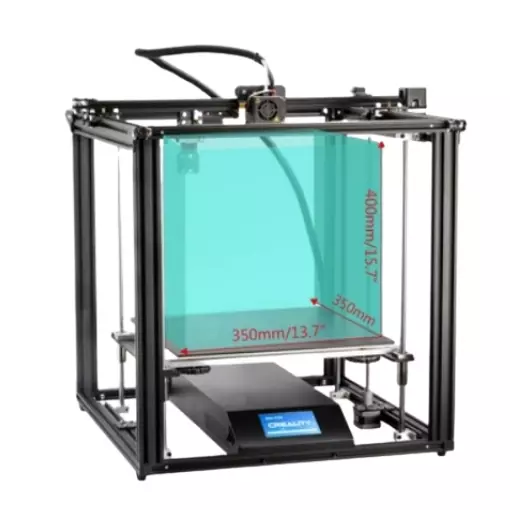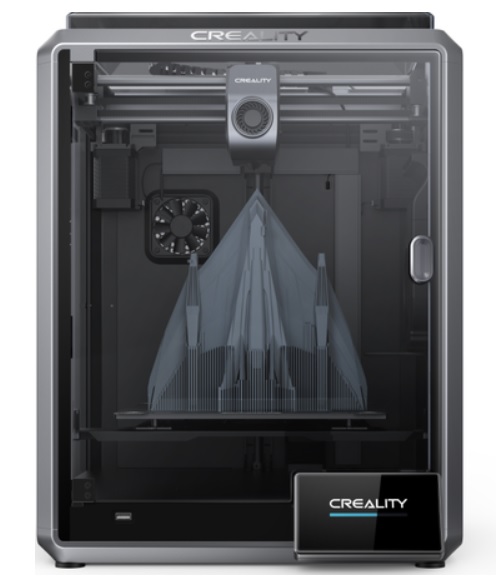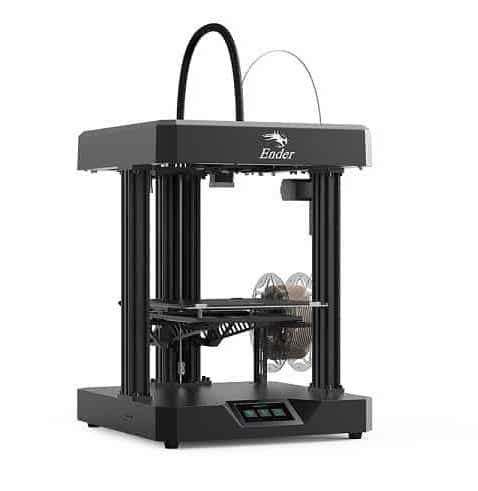Compare Ender 5 Plus vs K1 vs Ender 7
Comparison between the best 3D printers
Choose the best 3D printer at the best price. The cheapest 3D printers are here.
Buy a 3D printer here with 3D Fila.
 |
 |
 |
|
| Model | Ender 5 Plus[BUY Ender 5 Plus] |
K1[BUY K1] |
Ender 7[BUY Ender 7] |
| Printing Material | Filament | Filament | Filament |
| Estimated price | $599,00 | $399,00 | $429,00 |
| Fabricante | Creality 3D | Creality 3D | Creality 3D |
| Release Year | 2019 | 2023 | 2021 |
| Print Volume [mm] | 350x350x400 | 220x220x250 | 250x250x300 |
| Printer Size [mm] | 632x619x666 | 355x355x480 | 430x460x570 |
| Weight [kg] | 18,2 | 12,5 | 17,2 |
| Power Loss Recovery | YES | YES | YES |
| Enclosed printer | NO | YES | NO |
| Bed Leveling | Automatic | Automatic | Manual |
| Filament End Sensor | YES | YES | YES |
| Bed type | Heated | Heated | Heated |
| Power supply system | Bowden | Direct Drive | Bowden |
| Standard nozzle | 0,4 | 0,4 | 0,4 |
| Maximum Nozzle Temperature [°C] | 260 | 300 | 260 |
| Maximum Bed Temperature [°C] | 100 | 120 | 100 |
| Maximum printing speed [mm/s] | 180 | 600 | 250 |
| Filament holder | YES | YES | YES |
| Camera for supervision | NO | NO | NO |
| Recommended filaments | PLA, TPU, ABS, PETG | ABS, PLA, PETG, PET, TPU, PA, ABS, ASA, PC, PLA-CF, PA-CF, PET-CF | PLA, PETG, Tritan, Flex, ABS |
| Recommended slicers | Cura, Simplify, Slic3r | Creality Print; Cura, Simplify3D e PrusaSlicer | Cura, Simplify, Slic3r, IdeaMaker |
| Maximum Resolution [mm] | 0,1 | 0,1 | 0,1 |
| Processor | 32 bits | Creality CR-FDM V.2.4.S1_V101 32bits | |
| Display | Touchscreen TFT 4,3'' | Display touchscreen 4,3'' | Display touchscreen 4,3'' |
| Power Supply | 24V / 504W | 110/220V / 350W | 110/220V / 350W |
| Connectivity | SD / USB | Ethernet / USB / Wi-Fi | SD / USB |
| Operating systems | Windows, Mac, Linux | Windows, Mac, Linux | Windows, Mac, Linux |
| Date of registration in the system | 2021-04-14 | 2023-04-17 | 2022-11-04 |
| Release date | 2019 | 2023 | 2021 |
| Extra features | The Ender 5 Plus offers a large print volume (350x350x400 mm) and fast assembly. It includes a BLTouch sensor, but with range limitations. It stands out for its dimensional accuracy, although it requires adjustments to the slicer settings. Despite the noise, its integrated design saves space, and includes features such as a filament sensor and power resumption. Ideal for large projects, it requires refinement in the settings for high-quality prints. | The K1 is an extremely fast FDM 3D printer, reaching 600mm/s, 12 times faster than standard models. Equipped with a Core XY system and lightweight print head, it offers energy efficiency and high print quality. It stands out for its dual-gear extruder and quickly heated hotend, as well as dual cooling to prevent warping. Its robust structure ensures stability at high speed, with optimized software to speed up the printing process. | Crealitys Ender 7 printer offers remarkable print speeds, utilizing CoreXY kinematics for precise and fast movement. With a 250x250x300mm build area, dual direct extruder, and custom hotend, the Ender 7 is capable of printing at high speeds, although quality may suffer on smaller prints. Assembly is relatively straightforward, but the machine is noisy and can get hot. Its true speed potential is most noticeable on larger prints, where it outperforms its competitors. |
| Support for multiple colors and materials (AMS and CFS) | NO | NO | NO |
Notes * |
|||
| Cost-benefit | 6 / 10 | 8 / 10 | 7 / 10 |
| Hardware | 2 / 10 | 4.8 / 10 | 2.4 / 10 |
| Screen | . | . | . |
| Print volume | 4 / 10 | 3 / 10 | 4 / 10 |
| Performance | 1 / 10 | 5 / 10 | 2 / 10 |
| [BUY Ender 5 Plus] | [BUY K1] | [BUY Ender 7] |
Conclusion |
| In comparing the Ender 5 Plus, K1, and Ender 7 3D printers, several key elements emerge that guide consumers in making an informed decision. **Print Volume and Size:** The Ender 5 Plus offers the largest print volume, making it ideal for larger projects, while the K1 and Ender 7 provide adequate but smaller dimensions. This makes the Ender 5 Plus preferable for users with expansive print requirements. **Print Speed and Performance:** The K1 stands out with its exceptional printing speed of up to 600 mm/s, surpassing both the Ender 5 Plus and Ender 7. Its performance is enhanced by a dual-gear extruder and a lightweight print head, enabling it to maintain high print quality. The Ender 7 follows with commendable speed, particularly for larger prints, but it may face challenges with smaller items. **Features and Usability:** All three models include power loss recovery and filament end sensors. However, the K1's automatic bed leveling significantly enhances user experience relative to the manual leveling on the Ender 7 and Ender 5 Plus. Additionally, the K1's higher maximum nozzle and bed temperatures allow for a wider range of filament compatibility. **Build Quality and Stability:** While the Ender 5 Plus and Ender 7 are built with a more traditional design, the K1’s Core XY setup provides better stability and efficiency, especially at high speeds. This makes it less prone to warping and errors during prints. **Cost Consideration:** Though the K1 comes at a lower price, offering commendable value for its speed and features, the Ender 5 Plus, while pricier, delivers larger print volumes which could appeal to specific projects. **Overall Evaluation:** In summary, for those seeking speed and advanced features, the K1 is the clear winner, thanks to its innovative design and efficient printing capabilities. For users focused on larger prints without a stringent time requirement, the Ender 5 Plus remains a solid choice. Finally, the Ender 7 provides a good middle ground, but its susceptibility to noise and lower versatility may hinder its appeal for some users. Ultimately, the choice depends on individual needs concerning print size, speed, and budget constraints. |

